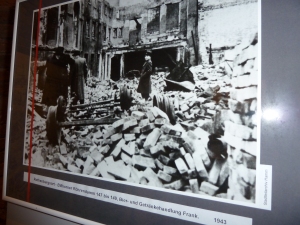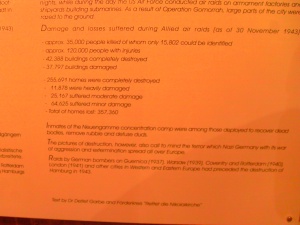I wasn’t sure what to think when I happened upon a memorial to victims of the war at St. Nikolai church in Hamburg, Germany. What remains of the church is basically a bell tower and a basement, some walls, now open-air, and art. What I hadn’t counted upon, after gaining admission, was the mention of Germans as victims. The Germans were the perpetrators, from the American perspective, from the global perspective. I hadn’t given much consideration to the civilian casualties of their nation’s war of atrocity.

St. Nikolai, in Hamburg, Germany, now serves as a memorial to victims of World War II. Photo credit: M. Ciavardini

Images of Hamburg’s destruction during the war on display in St. Nikolai. Photo credit: M. Ciavardini
There it was, right before me in the basement of this old church, destroyed in “Operation Gomorrah” by the Allies. More than 350,000 homes were lost and 35,000 people were killed—these were the casualties of the side that for so long had been winning.
This little commemoration—not mentioned in my guide book—unsettled me. I thought Nazis were mentioned a bit too far down in the written explanation. Truthfully, though, it had never occurred to me to think of the suffering of German people during the war.

A reminder at St. Nikolai about the German perspective of the war was unsettling. Photo credit: L. Tripoli
An old film by Roberto Rossellini, filmed in Berlin in 1947, reminds me of the perspective that hadn’t occurred to me and may not have occurred to many people. Germany Year Zero depicts the aftermath of the Germans’ spectacular defeat. Bombed-out buildings, food shortages, pedestrians fighting to cut pieces of a dead horse to eat, women using men for favors became elements of Berliners’ post-war existence that has largely gone unmentioned in the history I learned growing up.
Although I had a pleasant time in Germany, as I was in Hamburg on a press trip and enjoyed learning about the environmentally conscientious efforts of the city, that rotten past looms. Remnants of the badness remain. I suppose we would do well to remember that people on all sides of World War II experienced grim times.
© Lori Tripoli


